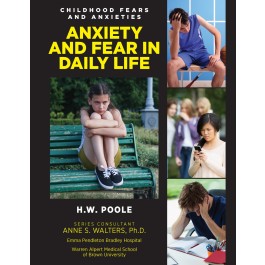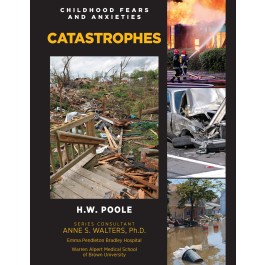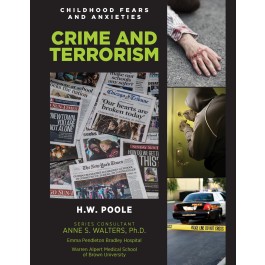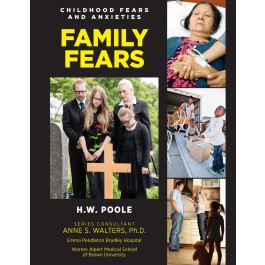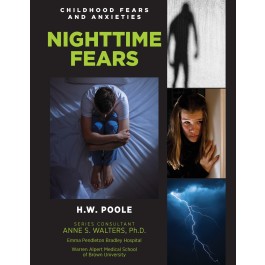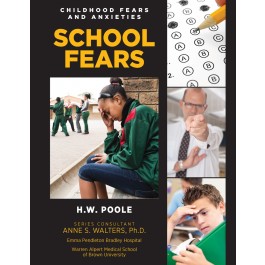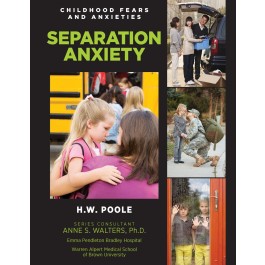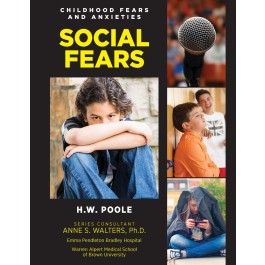CHILDHOOD FEARS AND ANXIETIES

10
2018
10+
5th - 8th
7 X 9
by H.W. Poole
| eBook | ISBN 978-1-4222-8055-3 | $26.95 | Add To Cart |
It's unavoidable: life is uncertain. None of us knows exactly what the future will bring. Learning to live with that uncertainty—to manage our fears rather than letting them manage us—is a vital skill that everyone must learn. This book explores why we feel anxiety and at how (believe it or not!) not all anxiety is bad. It also offers practical advice about what we can do when it feels like fear might be getting the best of us. Fear and anxiety are completely normal parts of growing up. Fear keeps us from climbing too high up that tree, while anxiety reminds us that we ought to study for that test tomorrow. But when anxiety gets out of control, it can rob kids of their educations, friends, and happiness. The set Childhood Fears and Anxieties takes a warm, supportive look at these feelings and how they can be managed.
Each title in this series includes color photos throughout, and back matter including: an index and further reading lists for books and internet resources. Key
Icons appear throughout the books in this series in an effort to encourage library readers to build knowledge, gain awareness, explore possibilities and expand their viewpoints through our content rich non-fiction books. Key Icons in this series are as follows: Words to Understand are shown at the front of each chapter with definitions. These words are set in boldfaced type in that chapter, so that readers are able to reference back to the definitions--building their vocabulary and enhancing their reading comprehension. Sidebars are highlighted graphics with content rich material within that allows readers to build knowledge and broaden their perspectives by weaving together additional information to provide realistic and holistic perspectives. Educational Videos are offered in chapters through the use of a QR code, that, when scanned, takes the student to an online video showing a moment in history, a speech, or an instructional video. This gives the readers additional content to supplement the text. Text-Dependent Questions are placed at the end of each chapter. They challenge the reader’s comprehension of the chapter they have just read, while sending the reader back to the text for more careful attention to the evidence presented there. Research Projects are provided at the end of each chapter as well and provide readers with suggestions for projects that encourage deeper research and analysis. And a Series Glossary of Key Terms is included in the back matter containing terminology used throughout the series. Words found here broaden the reader’s knowledge and understanding of terms used in this field.
by H.W. Poole
| Hardcover | ISBN 978-1-4222-3723-6 | $20.95 | Add To Cart |
| eBook | ISBN 978-1-4222-8056-0 | $26.95 | Add To Cart |
It’s natural that the very idea of catastrophes is scary for kids—after all, whether it’s a storm, a flood, or a fire, catastrophes can upend our lives. This book talks about how to manage our fears of these unlikely but possible events and stay mindfully in the present moment. It also suggests basic preparedness measures that may help reduce anxiety and discusses how to get help if a catastrophe should occur. Fear and anxiety are completely normal parts of growing up. Fear keeps us from climbing too high up that tree, while anxiety reminds us that we ought to study for that test tomorrow. But when anxiety gets out of control, it can rob kids of their educations, friends, and happiness. The set Childhood Fears and Anxieties takes a warm, supportive look at these feelings and how they can be managed.
Each title in this series includes color photos throughout, and back matter including: an index and further reading lists for books and internet resources. Key Icons appear
throughout the books in this series in an effort to encourage library readers to build knowledge, gain awareness, explore possibilities and expand their viewpoints through our content rich non-fiction books. Key Icons in this series are as follows: Words to Understand are shown at the front of each chapter with definitions. These words are set in boldfaced type in that chapter, so that readers are able to reference back to the definitions--building their vocabulary and enhancing their reading comprehension. Sidebars are highlighted graphics with content rich material within that allows readers to build knowledge and broaden their perspectives by weaving together additional information to provide realistic and holistic perspectives. Educational Videos are offered in chapters through the use of a QR code, that, when scanned, takes the student to an online video showing a moment in history, a speech, or an instructional video. This gives the readers additional content to supplement the text. Text-Dependent Questions are placed at the end of each chapter. They challenge the reader’s comprehension of the chapter they have just read, while sending the reader back to the text for more careful attention to the evidence presented there. Research Projects are provided at the end of each chapter as well and provide readers with suggestions for projects that encourage deeper research and analysis. And a Series Glossary of Key Terms is included in the back matter containing terminology used throughout the series. Words found here broaden the reader’s knowledge and understanding of terms used in this field.
by H.W. Poole
| Hardcover | ISBN 978-1-4222-3724-3 | $20.95 | Add To Cart |
| eBook | ISBN 978-1-4222-8057-7 | $26.95 | Add To Cart |
Statistics tell us that we are experiencing a uniquely safe period of history—but you wouldn’t know it from the evening news. This book looks at fears of violence, attempting to sort realistic concerns from unrealistic panic. By explaining concepts like probability and risk, as well as providing insight into how the media works, this book strives to help kids manage their anxieties about our uncertain world. Fear and anxiety are completely normal parts of growing up. Fear keeps us from climbing too high up that tree, while anxiety reminds us that we ought to study for that test tomorrow. But when anxiety gets out of control, it can rob kids of their educations, friends, and happiness. The set Childhood Fears and Anxieties takes a warm, supportive look at these feelings and how they can be managed.
Each title in this series includes color photos throughout, and back matter including: an index and further reading lists for books and internet resources. Key Icons appear throughout
the books in this series in an effort to encourage library readers to build knowledge, gain awareness, explore possibilities and expand their viewpoints through our content rich non-fiction books. Key Icons in this series are as follows: Words to Understand are shown at the front of each chapter with definitions. These words are set in boldfaced type in that chapter, so that readers are able to reference back to the definitions--building their vocabulary and enhancing their reading comprehension. Sidebars are highlighted graphics with content rich material within that allows readers to build knowledge and broaden their perspectives by weaving together additional information to provide realistic and holistic perspectives. Educational Videos are offered in chapters through the use of a QR code, that, when scanned, takes the student to an online video showing a moment in history, a speech, or an instructional video. This gives the readers additional content to supplement the text. Text-Dependent Questions are placed at the end of each chapter. They challenge the reader’s comprehension of the chapter they have just read, while sending the reader back to the text for more careful attention to the evidence presented there. Research Projects are provided at the end of each chapter as well and provide readers with suggestions for projects that encourage deeper research and analysis. And a Series Glossary of Key Terms is included in the back matter containing terminology used throughout the series. Words found here broaden the reader’s knowledge and understanding of terms used in this field.
by H.W. Poole
| Hardcover | ISBN 978-1-4222-3725-0 | $20.95 | Add To Cart |
| eBook | ISBN 978-1-4222-8058-4 | $26.95 | Add To Cart |
Families are the center of most kids’ lives—parents are their guides and protectors, while siblings are their first friends. Threats to family unity can be frightening, be it fighting and divorce, sickness and death, or some other issue, like deployment or deportation. This book explores various family fears and offers advice about how to manage anxiety about what might (but probably won’t) occur. Fear and anxiety are completely normal parts of growing up. Fear keeps us from climbing too high up that tree, while anxiety reminds us that we ought to study for that test tomorrow. But when anxiety gets out of control, it can rob kids of their educations, friends, and happiness. The set Childhood Fears and Anxieties takes a warm, supportive look at these feelings and how they can be managed.
Each title in this series includes color photos throughout, and back matter including: an index and further reading lists for books and internet resources. Key Icons appear throughout the books
in this series in an effort to encourage library readers to build knowledge, gain awareness, explore possibilities and expand their viewpoints through our content rich non-fiction books. Key Icons in this series are as follows: Words to Understand are shown at the front of each chapter with definitions. These words are set in boldfaced type in that chapter, so that readers are able to reference back to the definitions--building their vocabulary and enhancing their reading comprehension. Sidebars are highlighted graphics with content rich material within that allows readers to build knowledge and broaden their perspectives by weaving together additional information to provide realistic and holistic perspectives. Educational Videos are offered in chapters through the use of a QR code, that, when scanned, takes the student to an online video showing a moment in history, a speech, or an instructional video. This gives the readers additional content to supplement the text. Text-Dependent Questions are placed at the end of each chapter. They challenge the reader’s comprehension of the chapter they have just read, while sending the reader back to the text for more careful attention to the evidence presented there. Research Projects are provided at the end of each chapter as well and provide readers with suggestions for projects that encourage deeper research and analysis. And a Series Glossary of Key Terms is included in the back matter containing terminology used throughout the series. Words found here broaden the reader’s knowledge and understanding of terms used in this field.
by H.W. Poole
| Hardcover | ISBN 978-1-4222-3726-7 | $20.95 | Add To Cart |
| eBook | ISBN 978-1-4222-8059-1 | $26.95 | Add To Cart |
Let’s face it, not many of us enjoy going to the doctor. But some people genuinely fear the doctor, dentist, or hospital—some are terrified of tests, others of needles, and still others are anxious about being judged. This book looks into the many things that unnerve patients and provides concrete tips about how to make doctor visits a little less scary. Fear and anxiety are completely normal parts of growing up. Fear keeps us from climbing too high up that tree, while anxiety reminds us that we ought to study for that test tomorrow. But when anxiety gets out of control, it can rob kids of their educations, friends, and happiness. The set Childhood Fears and Anxieties takes a warm, supportive look at these feelings and how they can be managed.
Each title in this series includes color photos throughout, and back matter including: an index and further reading lists for books and internet resources. Key Icons appear throughout the books in this series in an effort to encourage
library readers to build knowledge, gain awareness, explore possibilities and expand their viewpoints through our content rich non-fiction books. Key Icons in this series are as follows: Words to Understand are shown at the front of each chapter with definitions. These words are set in boldfaced type in that chapter, so that readers are able to reference back to the definitions--building their vocabulary and enhancing their reading comprehension. Sidebars are highlighted graphics with content rich material within that allows readers to build knowledge and broaden their perspectives by weaving together additional information to provide realistic and holistic perspectives. Educational Videos are offered in chapters through the use of a QR code, that, when scanned, takes the student to an online video showing a moment in history, a speech, or an instructional video. This gives the readers additional content to supplement the text. Text-Dependent Questions are placed at the end of each chapter. They challenge the reader’s comprehension of the chapter they have just read, while sending the reader back to the text for more careful attention to the evidence presented there. Research Projects are provided at the end of each chapter as well and provide readers with suggestions for projects that encourage deeper research and analysis. And a Series Glossary of Key Terms is included in the back matter containing terminology used throughout the series. Words found here broaden the reader’s knowledge and understanding of terms used in this field.
by H.W. Poole
| Hardcover | ISBN 978-1-4222-3727-4 | $20.95 | Add To Cart |
| eBook | ISBN 978-1-4222-8060-7 | $26.95 | Add To Cart |
If you are afraid of the dark, you are not alone. In fact, it’s one of the most common fears kids have—and it can plague adults, too! And fear of the dark is just the beginning: whether you’re troubled by monsters or burglars or tomorrow’s math quiz, nighttime can be a scary period for many of us. This book explores the fear of things that go bump in the night and provides concrete tips on what you can do to conquer those fears. Fear and anxiety are completely normal parts of growing up. Fear keeps us from climbing too high up that tree, while anxiety reminds us that we ought to study for that test tomorrow. But when anxiety gets out of control, it can rob kids of their educations, friends, and happiness. The set Childhood Fears and Anxieties takes a warm, supportive look at these feelings and how they can be managed.
Each title in this series includes color photos throughout, and back matter including: an index and further reading lists for books and internet resources. Key
Icons appear throughout the books in this series in an effort to encourage library readers to build knowledge, gain awareness, explore possibilities and expand their viewpoints through our content rich non-fiction books. Key Icons in this series are as follows: Words to Understand are shown at the front of each chapter with definitions. These words are set in boldfaced type in that chapter, so that readers are able to reference back to the definitions--building their vocabulary and enhancing their reading comprehension. Sidebars are highlighted graphics with content rich material within that allows readers to build knowledge and broaden their perspectives by weaving together additional information to provide realistic and holistic perspectives. Educational Videos are offered in chapters through the use of a QR code, that, when scanned, takes the student to an online video showing a moment in history, a speech, or an instructional video. This gives the readers additional content to supplement the text. Text-Dependent Questions are placed at the end of each chapter. They challenge the reader’s comprehension of the chapter they have just read, while sending the reader back to the text for more careful attention to the evidence presented there. Research Projects are provided at the end of each chapter as well and provide readers with suggestions for projects that encourage deeper research and analysis. And a Series Glossary of Key Terms is included in the back matter containing terminology used throughout the series. Words found here broaden the reader’s knowledge and understanding of terms used in this field.
by H.W. Poole
| Hardcover | ISBN 978-1-4222-3728-1 | $20.95 | Add To Cart |
| eBook | ISBN 978-1-4222-8061-4 | $26.95 | Add To Cart |
The word phobia is often used as a joke—a kid might say he has a phobia of spinach, when all he really means is that he dislikes the taste. But for people with genuine phobias, the condition is no laughing matter. Whether it’s heights or crowds or plane travel, phobias can make life very difficult. This book introduces readers to the most common phobias and provides useful advice about how these fears can be conquered. Fear and anxiety are completely normal parts of growing up. Fear keeps us from climbing too high up that tree, while anxiety reminds us that we ought to study for that test tomorrow. But when anxiety gets out of control, it can rob kids of their educations, friends, and happiness. The set Childhood Fears and Anxieties takes a warm, supportive look at these feelings and how they can be managed.
Each title in this series includes color photos throughout, and back matter including: an index and further reading lists for books and internet resources. Key Icons appear
throughout the books in this series in an effort to encourage library readers to build knowledge, gain awareness, explore possibilities and expand their viewpoints through our content rich non-fiction books. Key Icons in this series are as follows: Words to Understand are shown at the front of each chapter with definitions. These words are set in boldfaced type in that chapter, so that readers are able to reference back to the definitions--building their vocabulary and enhancing their reading comprehension. Sidebars are highlighted graphics with content rich material within that allows readers to build knowledge and broaden their perspectives by weaving together additional information to provide realistic and holistic perspectives. Educational Videos are offered in chapters through the use of a QR code, that, when scanned, takes the student to an online video showing a moment in history, a speech, or an instructional video. This gives the readers additional content to supplement the text. Text-Dependent Questions are placed at the end of each chapter. They challenge the reader’s comprehension of the chapter they have just read, while sending the reader back to the text for more careful attention to the evidence presented there. Research Projects are provided at the end of each chapter as well and provide readers with suggestions for projects that encourage deeper research and analysis. And a Series Glossary of Key Terms is included in the back matter containing terminology used throughout the series. Words found here broaden the reader’s knowledge and understanding of terms used in this field.
by H.W. Poole
| Hardcover | ISBN 978-1-4222-3729-8 | $20.95 | Add To Cart |
| eBook | ISBN 978-1-4222-8062-1 | $26.95 | Add To Cart |
School looms large in most kids’ lives, so it makes sense that school-related anxieties loom equally large. Whether it’s hard tests or scary teachers, getting along with friends or simply getting by in gym, school can provoke many different anxieties in different kids. This book discusses a whole range of potentially scary situations and offers concrete advice about what kids can do to feel better. Fear and anxiety are completely normal parts of growing up. Fear keeps us from climbing too high up that tree, while anxiety reminds us that we ought to study for that test tomorrow. But when anxiety gets out of control, it can rob kids of their educations, friends, and happiness. The set Childhood Fears and Anxieties takes a warm, supportive look at these feelings and how they can be managed.
Each title in this series includes color photos throughout, and back matter including: an index and further reading lists for books and internet resources. Key Icons appear throughout the books in
this series in an effort to encourage library readers to build knowledge, gain awareness, explore possibilities and expand their viewpoints through our content rich non-fiction books. Key Icons in this series are as follows: Words to Understand are shown at the front of each chapter with definitions. These words are set in boldfaced type in that chapter, so that readers are able to reference back to the definitions--building their vocabulary and enhancing their reading comprehension. Sidebars are highlighted graphics with content rich material within that allows readers to build knowledge and broaden their perspectives by weaving together additional information to provide realistic and holistic perspectives. Educational Videos are offered in chapters through the use of a QR code, that, when scanned, takes the student to an online video showing a moment in history, a speech, or an instructional video. This gives the readers additional content to supplement the text. Text-Dependent Questions are placed at the end of each chapter. They challenge the reader’s comprehension of the chapter they have just read, while sending the reader back to the text for more careful attention to the evidence presented there. Research Projects are provided at the end of each chapter as well and provide readers with suggestions for projects that encourage deeper research and analysis. And a Series Glossary of Key Terms is included in the back matter containing terminology used throughout the series. Words found here broaden the reader’s knowledge and understanding of terms used in this field.
by H.W. Poole
| Hardcover | ISBN 978-1-4222-3730-4 | $20.95 | Add To Cart |
| eBook | ISBN 978-1-4222-8063-8 | $26.95 | Add To Cart |
Because anxiety doesn’t feel very good, we tend to think it’s always bad. But separation anxiety—or the fear of being apart from people you love—is a totally normal part of child development. It’s also something we’re meant to outgrow. When that doesn’t happen, separation anxiety can indeed become a big problem. This book looks at separation anxiety both as a phase and as a condition, and it offers practical advice about how to conquer these fears. Fear and anxiety are completely normal parts of growing up. Fear keeps us from climbing too high up that tree, while anxiety reminds us that we ought to study for that test tomorrow. But when anxiety gets out of control, it can rob kids of their educations, friends, and happiness. The set Childhood Fears and Anxieties takes a warm, supportive look at these feelings and how they can be managed.
Each title in this series includes color photos throughout, and back matter including: an index and further reading lists for books
and internet resources. Key Icons appear throughout the books in this series in an effort to encourage library readers to build knowledge, gain awareness, explore possibilities and expand their viewpoints through our content rich non-fiction books. Key Icons in this series are as follows: Words to Understand are shown at the front of each chapter with definitions. These words are set in boldfaced type in that chapter, so that readers are able to reference back to the definitions--building their vocabulary and enhancing their reading comprehension. Sidebars are highlighted graphics with content rich material within that allows readers to build knowledge and broaden their perspectives by weaving together additional information to provide realistic and holistic perspectives. Educational Videos are offered in chapters through the use of a QR code, that, when scanned, takes the student to an online video showing a moment in history, a speech, or an instructional video. This gives the readers additional content to supplement the text. Text-Dependent Questions are placed at the end of each chapter. They challenge the reader’s comprehension of the chapter they have just read, while sending the reader back to the text for more careful attention to the evidence presented there. Research Projects are provided at the end of each chapter as well and provide readers with suggestions for projects that encourage deeper research and analysis. And a Series Glossary of Key Terms is included in the back matter containing terminology used throughout the series. Words found here broaden the reader’s knowledge and understanding of terms used in this field.
by H.W. Poole
| Hardcover | ISBN 978-1-4222-3731-1 | $20.95 | Add To Cart |
| eBook | ISBN 978-1-4222-8064-5 | $26.95 | Add To Cart |
Lots of people are shy, and there’s nothing wrong with that—unless you find that your shyness is preventing you from doing what you want. Some people are so shy that raising their hands in class or even simply saying “hello” to a stranger can be overwhelming. This book looks at the types of social fears that can hold us back and provides advice about how to overcome them. Fear and anxiety are completely normal parts of growing up. Fear keeps us from climbing too high up that tree, while anxiety reminds us that we ought to study for that test tomorrow. But when anxiety gets out of control, it can rob kids of their educations, friends, and happiness. The set Childhood Fears and Anxieties takes a warm, supportive look at these feelings and how they can be managed.
Each title in this series includes color photos throughout, and back matter including: an index and further reading lists for books and internet resources. Key Icons appear throughout the books in this series in an
effort to encourage library readers to build knowledge, gain awareness, explore possibilities and expand their viewpoints through our content rich non-fiction books. Key Icons in this series are as follows: Words to Understand are shown at the front of each chapter with definitions. These words are set in boldfaced type in that chapter, so that readers are able to reference back to the definitions--building their vocabulary and enhancing their reading comprehension. Sidebars are highlighted graphics with content rich material within that allows readers to build knowledge and broaden their perspectives by weaving together additional information to provide realistic and holistic perspectives. Educational Videos are offered in chapters through the use of a QR code, that, when scanned, takes the student to an online video showing a moment in history, a speech, or an instructional video. This gives the readers additional content to supplement the text. Text-Dependent Questions are placed at the end of each chapter. They challenge the reader’s comprehension of the chapter they have just read, while sending the reader back to the text for more careful attention to the evidence presented there. Research Projects are provided at the end of each chapter as well and provide readers with suggestions for projects that encourage deeper research and analysis. And a Series Glossary of Key Terms is included in the back matter containing terminology used throughout the series. Words found here broaden the reader’s knowledge and understanding of terms used in this field.
by H.W. Poole
| Hardcover | ISBN 978-1-4222-3732-8 | $20.95 | Add To Cart |
| eBook | ISBN 978-1-4222-8065-2 | $26.95 | Add To Cart |
Anxiety disorders are by far the most common mental-health challenge for kids and teenagers. This book introduces readers to the various types of anxiety disorders, including generalized anxiety disorder, panic disorder, and more. Readers will also find an overview of the different treatments and types of therapy available, as well as practical tips on anxiety management. Fear and anxiety are completely normal parts of growing up. Fear keeps us from climbing too high up that tree, while anxiety reminds us that we ought to study for that test tomorrow. But when anxiety gets out of control, it can rob kids of their educations, friends, and happiness. The set Childhood Fears and Anxieties takes a warm, supportive look at these feelings and how they can be managed.
Each title in this series includes color photos throughout, and back matter including: an index and further reading lists for books and internet resources. Key Icons appear throughout the books in this series in an effort to
encourage library readers to build knowledge, gain awareness, explore possibilities and expand their viewpoints through our content rich non-fiction books. Key Icons in this series are as follows: Words to Understand are shown at the front of each chapter with definitions. These words are set in boldfaced type in that chapter, so that readers are able to reference back to the definitions--building their vocabulary and enhancing their reading comprehension. Sidebars are highlighted graphics with content rich material within that allows readers to build knowledge and broaden their perspectives by weaving together additional information to provide realistic and holistic perspectives. Educational Videos are offered in chapters through the use of a QR code, that, when scanned, takes the student to an online video showing a moment in history, a speech, or an instructional video. This gives the readers additional content to supplement the text. Text-Dependent Questions are placed at the end of each chapter. They challenge the reader’s comprehension of the chapter they have just read, while sending the reader back to the text for more careful attention to the evidence presented there. Research Projects are provided at the end of each chapter as well and provide readers with suggestions for projects that encourage deeper research and analysis. And a Series Glossary of Key Terms is included in the back matter containing terminology used throughout the series. Words found here broaden the reader’s knowledge and understanding of terms used in this field.











